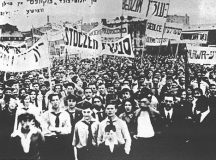It is hard to imagine a more fitting time for a study of Abba Ahimeir, not only because his ideas may have been critical for the making of the Israeli far-right, but more importantly, because his views show how easy it is for intellectuals to get swept up into a near-paralysing yet plausible pessimism.
For anyone coming of age in a Europe fragmented by war, revolution, and social chaos, there were countless reasons for despair, but for the Jews it appeared as if that first unexpected and prolonged war of the 20th century had dropped them into a bubbling cauldron as conspiracies took hold of the popular imagination, with Jews positioned at their very centre.
Abba Ahimeir was an ideologue of Revisionist Zionism, the founder of the Revisionist Maximalist faction of the Zionist Revisionist Movement and of the clandestine Brit HaBirionim. The story Peter Bergamin tells of Ahimier is moulded around a set of arguments and assumptions that feel both specific and universal. With meticulous research he gives us the fullest possible picture of Abba Ahimeir, always guided by the available evidence. No memoirs or trove of personal letters enable historians to penetrate Ahimeir’s psyche and, to his credit, Bergamin resists the temptation to speculate on matters that cannot be verified, such as the man’s inner thoughts and emotions following his arrest in 1933 in connection with the assassination of Haim Arlosoroff, who had concluded the so-called Transfer Agreement with a Germany ruled by Nazis. Although never convicted, when new leaders of the radical Right arose, they made sure never to offer a tribute to the man who had actually invented the vocabulary they used when they turned their attacks against the British, or when they called for righteous zeal and an absolute willingness to sacrifice life and limb for the cause of establishing a Jewish state.
The Making of the Israeli Far Right begins its analysis of Ahimeir’s ideology with a place — the Herzlia Gymnasium — where Zionist ideas were injected into the hearts and minds of students. Returning home to Russia for what was expected to be a summer vacation in 1914, Ahimeir’s studies and life were soon disrupted by a world war, then interrupted by a revolution, and finally shattered by the death of a beloved younger brother. These events eventually led him to the University of Vienna where he wrote a doctoral dissertation on Oswald Spengler’s conception of Russia. Attracted to the overall thrust of Spengler’s binary historical framework and to his notion of civilisational exhaustion, Ahimeir never wavered in his belief that Zionism was the only way Jews could resist the malaise sapping democracies of their power, prosperity, and stability, while arresting the momentum of the forces wearing down their Jewish distinctiveness.
But it is Ahimeir’s flirtation with fascism that has left the indelible image of him and of his contribution to Zionism. The distinctiveness of Bergamin’s book lies in his reworking of this image — deconstructing its elements to explain how they do not all fit neatly together. From a careful parsing of Ahimeir’s published and unpublished essays, Bergamin allows us to see someone who, despite insisting on how much he valued deeds rather than words, lived by writing and speaking as a form of action.
Ironically, the dangers confronting Jews compelled Ahimeir’s attention because they came from the very movement for which he initially worked when he returned to Palestine in the 1920s — that is, of the Left. Writing for a paper published by the non-Marxist Hapoel Hatzair labour youth movement, he criticised Labor Zionism for trying to find common ground with socialist parties in other countries and for caring deeply about how this global community viewed the Zionist project.
Because Labor Zionism generated ambitions not only for a state and society, like all other nations, but also for redemption, it tended to believe that a Jewish state must provide a new kind of social order without hierarchy or exploitation, and with justice and equality for all. This produced a dangerous impulse, Ahimeir contended, to subordinate the struggle for Jewish sovereignty to the humanistic mission for radical social change. Seeing history as a grim struggle for survival, Ahimeir denounced Labor Zionism’s search for affirmation from socialists in other countries for its own utopian visions. Casting their differences into sharp relief, Ahimeir emphasised that what was on offer from socialism was merely the chance for Jews to erase their uniqueness and use their energy to solidify a future without national cultures or religious identities.
While noting that for far too many the road to Tel Aviv passed through Moscow, Ahimeir insisted that no degree of ideological flexibility could bridge or manage the gap between the Labor Zionist goal to revitalise and modernise Jewish culture and the socialist aim predicated on an ideal society dissolving Jewish identity.
For Ahimeir, the British Mandate’s first decade rendered the need to explore the relationship between words and deeds urgent. Partly because the rules structuring public life in Palestine were not yet firmly fixed, Ahimeir constantly reflected on how to uncover the mechanisms by which ideas achieve their intended effects. While he set great store by words, he became increasingly in the grip of a longing for consummate acts of violence or resistance against British mandatory policies. He claimed that the Zionist establishments’ collusion with Great Britain and its rather passive acceptance of Mandatory policies undermined the possibilities for both Jewish statehood and Jewish rejuvenation.
Putting such weight on Ahimeir’s philosophy increases the stakes of interpreting it correctly. And while Bergamin exercises extraordinary care investigating Ahimeir’s understanding of violence, seeing Ahimeir as a critically important voice for the ideas later adopted by Israel’s so-called far Right leads to some striking omissions. In his several insights into Ahimeir’s embrace of violence, Bergamin does not take up the question of whether such a strategy — had it been adopted — would have undermined the Zionist cause by unravelling the very premises for granting the British a Mandate for Palestine. The notion that the Zionists could fulfil their national ambition only on the battlefield and not in the halls of colonial offices might well have convinced the British that support for the development of a Jewish National Home in Palestine would not serve their own domestic interests in a post-war era of financial constraints and pressing economic challenges.
There is no need to wrestle with imponderables or speculate what items may be on a list of imaginary adverse consequences if Great Britain had stopped backing the Jewish National Home. In the aftermath of Palestine’s 1929 riots, had the Passfield White Paper framed British mandatory policies from 1930, the Zionist project could easily have collapsed. Nullifying the expected payoffs — material and strategic — for backing the Zionist project would have ruptured a critical relationship that granted the Jewish National Home international legitimacy and the time required for critical demographic growth and economic development. Until the Yishuv could stand on its own, the leaders of Palestine’s Jewish community knew that if it was forced to dwell alone, it would face grim prospects. A Jewish state might be a cause worthy of personal sacrifice, but the entire enterprise would be at stake in the strategy contemplated by Ahimeir in the 1920s.
According to Bergamin, Ahimeir’s departure from Zionist orthodoxy and his argument for a sharp and public break from Mandatory policies, nevertheless, won praise from a number of Revisionists. Ahimeir’s writings and teachings were tantamount to a call for a crusade against a Zionist consensus on the importance of remaining part of the British colonial system, first issued in secret through his teaching at the Beitar Leadership Training School and his nurturing of Brit ha-Biryonim activities, which in time led to his own participation in acts of civil disobedience against Mandate authorities.
Bergamin invests Ahimeir with a kind of oracular authority over what he calls Israel’s Far Right, but he also notes a certain ambivalence in Ahimeir’s views on violence. Ahimeir’s most explicit essay on terrorism — ‘The Scroll of the Sicarii’ — remained unpublished and was, he claimed, only a scholarly investigation of the apocalyptic period during the Roman siege of Jerusalem that ended with the destruction of the Second Temple. Still, Bergamin tries to draw a straight line between Ahimeir’s Zionism to that of Lehi and Irgun. But even this relatively short line — separated by a decade or so — has too many turns to clinch a causal connection.
The ‘Far Right’ is a notoriously slippery category never bounded by exact proportions nor comprised of the same elements or constituents, particularly in relation to violence. And while violence may have captured the imagination of some associated with Beitar, it was not entirely absent from the menu of tactics adopted by Labor Zionism which always combined a recognition — whether or not it was publicly acknowledged — that violence would be necessary for defence and that as a way to escape doom, it was morally justified.
In his final pages, Bergamin regrets how much of Ahimeir’s life and intellectual development must be left without comment. For the ‘Far Right’, Ahimeir’s name became toxic even as more of his ideas entered the Zionist ideological mainstream. When Ahimeir died in 1962, he had lived through a period of Jewish history as eventful as any. If he wasn’t broken by his marginalisation, he was, nevertheless, relatively silenced. Not surprisingly, what made Ahimeir famous also made him widely misunderstood and easily forgotten.





































